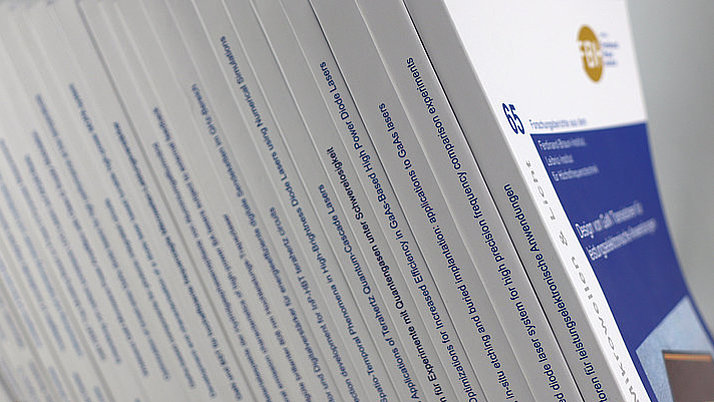226 nm Far-Ultraviolet-C Light Emitting Diodes with an Emission Power over 2 mW
T. Kolbe, H.K. Cho, S. Hagedorn, J. Rass, J. Ruschel, S. Einfeldt, and M. Weyers
Published in:
phys. stat. sol. (rrl), vol. 18, no. 11, pp. 2400092, doi:10.1002/pssr.202400092 (2024).
Abstract:
Far-ultraviolet-C (far-UVC) light emitting diodes (LED) emitting at an emission wavelength of 226 nm with different n-AlGaN contact layers, quantum well barriers, and quantum well numbers are compared regarding their emission power, operation voltage, and lifetime. Electroluminescence measurements show higher emission power but also an increased operation voltage with increasing Al mole fraction in the n-AlGaN contact layer. Furthermore, it is found that both the mean emission power and the device lifetime decrease with increasing Al mole fraction (82–89%) of the quantum well barriers and therefore with increasing barrier height. Finally, 226 nm LEDs with 6 and 9 quantum wells are compared. It is observed that the sample with 9 quantum wells shows an around 30% lower mean emission power but, in contrast, the L70 lifetime of these LEDs is higher by a factor of around five. Based on these optimizations, 226 nm LEDs with a maximum external quantum efficiency of 0.28% (wall plug efficiency of 0.18%) as well as an emission power of 2.1 mW and an operation voltage of 9.6 V at 200 mA are realized.
Ferdinand-Braun-Institut (FBH), Gustav-Kirchhoff-Str. 4, 12489 Berlin, Germany
Keywords:
carrier confinement, efficiency, far-UVC LED, heterostructure, MOVPE, quantum well barrier, reliability
© 2024 The Authors. physica status solidi (RRL) Rapid Research Letters published by Wiley-VCH GmbH. This is an open access article under the terms of the Creative Commons Attribution-NonCommercial-NoDerivs License, which permits use and distribution in any medium, provided the original work is properly cited, the use is non-commercial and no modifications or adaptations are made.
Rightslink® by Copyright Clearance Center
Full version in pdf-format.


